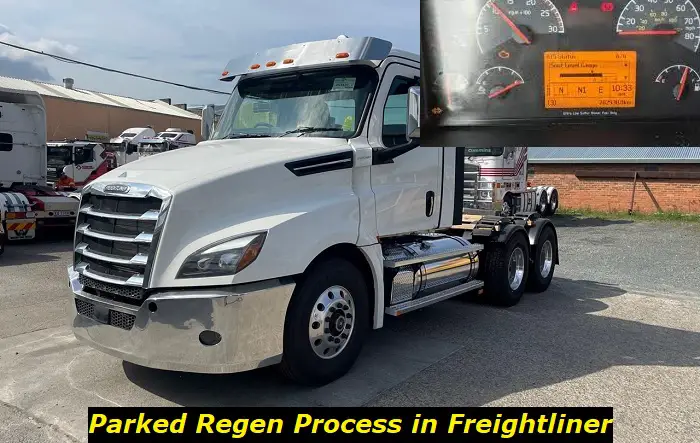How Long Does a Parked Regen Take Freightliner? Effective Regeneration Process
Regeneration, or regen, refers to the process by which a Freightliner, or any other heavy-duty diesel vehicle, removes particulate matter from the diesel particulate filter (DPF) in the exhaust system. The process involves heating up and burning off this accumulated soot, effectively 'regenerating' the DPF. Among the types of regeneration, such as active and passive regen, a parked regen is a manual procedure that the driver must initiate when the vehicle is not in motion.

A Freightliner requires a parked regen because, without regular regeneration, the DPF can become excessively clogged, leading to poor vehicle performance and potentially serious damage. The duration of a parked regen can vary and it depends on several factors. These factors include the level of soot in the DPF, the age and condition of the vehicle, the type of driving (e.g., city or highway), and external factors like weather conditions. We will delve into those factors to understand how they influence the length of a parked regeneration.
Why Does a Freightliner Need Parked Regen?
As an experienced mechanic, I can attest that one of the key maintenance practices for a Freightliner, or any diesel engine vehicle, is the act of performing a parked regen. This need arises out of the essential function of the diesel particulate filter, or DPF, which traps soot particles produced during the combustion process.
The DPF is a crucial component in maintaining the health and efficiency of a Freightliner engine. If your Freightliner continually operates without clearing out this filter, the accumulation of soot particles can lead to the DPF becoming clogged. This blockage is more than just a minor inconvenience; it can result in a drastic drop in the vehicle's performance, reducing its power and fuel efficiency.
Furthermore, it might culminate in significant engine damage and potentially expensive repairs down the line. The parked regen process serves to prevent such consequences. By initiating a parked regen, the trapped soot in the DPF is effectively burned off, clearing the filter and restoring the functionality of your Freightliner engine.
In essence, the need for conducting a parked regen arises to ensure the longer lifespan of the DPF and maintain the engine's performance. This is a necessary procedure to keep a Freightliner running smoothly and efficiently over long periods.
Understanding the Duration of a Parked Regen
When it comes to parked regen, many Freightliner drivers often wonder about the time it takes for the process to be completed. This is an essential concern as a planned parked regen can dictate the schedule of your day's haul. The duration can vary and is not a consistent or fixed period.
The process can take anywhere from 20 to 60 minutes under normal conditions, but this is far from a hard and fast rule. While we do not usually see the procedure stretching beyond the hour mark, it is crucial to note that extenuating circumstances and variations in vehicle conditions can lengthen this timeframe.
The duration of a parked regen is dependent on the amount of soot that has accumulated within the DPF. This can be influenced by your engine's health and the type of driving you typically do. For instance, a vehicle often used for stop-and-start city driving will likely collect soot at a faster rate compared to one used predominantly for longer, highway hauls. Therefore, you might find yourself needing to perform a regeneration more often or noticing that regen cycles take longer than those in a highway-heavy vehicle.
While it's important to keep these factors in mind, always remember that a parked rescheduling that seems overly long or unusually frequent could be indicative of an underlying issue. Such symptoms should not be ignored and the vehicle must be checked by a professional to avoid any serious issues in the future.
Factors Influencing the Length of a Parked Regen
There are specific elements that significantly influence the length of a parked regeneration in a Freightliner. Understanding these factors can help you plan better and reduce downtime of your heavy machinery.
The level of soot in the Diesel Particulate Filter (DPF) is arguably the most significant determinant of the time a parked regen will take. When there's a high soot level, the regen process takes longer because there will be more particulate matter to burn off.
A second crucial factor is the age and the overall condition of the vehicle. In general terms, an older Freightliner or one not properly maintained might require a lengthier regen process compared to a newer or well-maintained vehicle. This is largely because older vehicles tend to have more worn-out parts, leading to less efficient combustion and hence more soot production. Also, faulty sensors or DPF itself can delay the regen process.
The type of driving you do also affects the regen time. For instance, city driving with a lot of stop-and-go traffic tends to create more soot because the engine doesn't reach optimal temperatures for passive regen to happen. Consequently, a vehicle used predominantly for city driving may require frequent parked regens that take more time. On the other hand, highway driving allows the engine to achieve ideal temperatures for passive regen, hence reducing the frequency and length of parked regens.
Lastly, external factors like weather conditions also play a role. In cold weather, for instance, it might take longer for the DPF to reach the necessary temperatures for burning off the soot. Therefore, regens during winter may need more time than those done in warmer weather.
In essence, the duration of a parked regen in a Freightliner is not fixed; it fluctuates based on various conditions. Being aware of these factors can help you optimize the process and ensure that the vehicle is operating efficiently at all times.
How to Run a Successful Parked Regen on a Freightliner
Carrying out a successful parked regen on a Freightliner is an essential skill that every driver should have under their belt. Before embarking on this process, however, it is crucial to ensure that the vehicle is parked safely on a level ground, preferably away from flammable materials given the high exhaust temperatures at the rear-end during the process.
Start by turning on your Freightliner but keep the engine at idle. You then engage the parking brakes and ensure that the transmission is in neutral. From there, access the 'Vehicle Info' menu on the informational display dashboard and navigate to 'Regen Recommended.' If your vehicle requires a regen, this option will be displayed.
Next, you need to press and hold the DPF button on your dashboard. Keep in mind that the DPF button should only be held when the engine is at idle and not while it's being revved. After a few seconds, an orange light will indicate that the process has begun. You'll need to keep the engine running idle throughout the process -this is vital.
The regen can take anywhere from 20 minutes to an hour or more. Do not throttle the engine or release the parking brakes during this time. Once the process is completed, the light will turn off and you can then go back to regular operation.
Remember, the key to a successful parked regen lies in proper initiation and patient waiting. Interruptions can lead to an incomplete regen and continuous buildup of soot, which will, in turn, necessitate more frequent regens and could potentially lead to damage in the long run.
Troubleshooting Common Issues During Parked Regen Process
It's quite common to encounter a few bumps along the road while performing a parked regeneration on your Freightliner. Rest assured, many of these are easily rectifiable with a bit of understanding and hands-on insight. Let's address some of the more common hitches you might experience during this crucial process.
If your vehicle won't initiate the parked regen, the first port of call is to check the engine's RPM. For the regeneration process to commence, the engine's RPM should ideally be in the idle range. There's a possibility that the engine RPM is too high, which can prevent the regen process from starting. Adjust the engine speed, then try to initiate the parked regen again.
Another issue might be an interrupted regen process. If your regen process keeps stopping or it's not completing, this could be due to a drop in the necessary exhaust temperature. Bear in mind that the exhaust temperature needs to be sufficiently high for a complete regeneration. If the temperature drops midway, the regen process will halt. Readjust the engine speed to increase the exhaust temperature, and restart the regeneration process.
There could be situations where the parked regen is taking too long, or longer than you expected. This could indicate a high soot load in the Diesel Particulate Filter (DPF) which is common when driving conditions are primarily city or heavy traffic where the truck isn't able to reach the required exhaust temperature for regen. In such scenarios, the DPF might require a forced or manual regen.
Remember, the frequency and duration of regens can also vary with age, driving conditions, and upkeep of the vehicle.
If you've tried troubleshooting but the issues persist, further diagnosis may be required using advanced tools or you might need to seek professional help. In such cases, don't hesitate to reach out to a certified technician or your nearest Freightliner service center.

Add comment